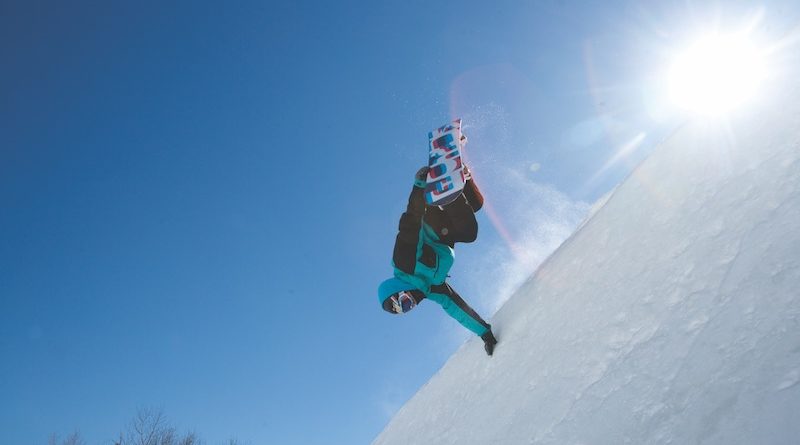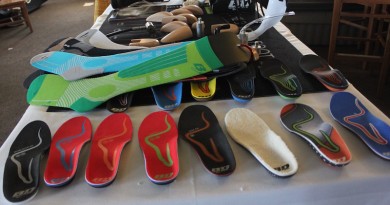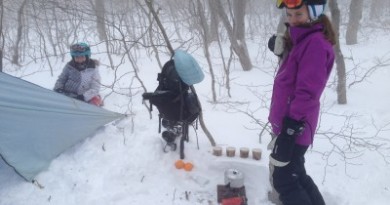Why Put a Lid on It?
A new study by UVM doctors and researchers takes a fresh look at helmets and other factors in skier safety—and just how effective they are at keeping skiers safe.
In the far corner of a warehouse located on the Burton campus in Burlington lies the helmet testing machine. The machine looks a little like something you might find at a traveling carnival—but really shiny and new.
To test Burton’s line of Anon helmets, helmet engineer Dave Connery places a 5
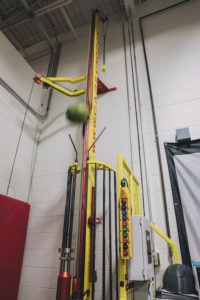
kilogram solid metal mannequin’s head inside of a helmet. He chooses from one of several shudder-inducing metal objects (a flat-headed peg, a metal fin, a hemispherical surface and one terrifying metal spike, called the “penetration tester”), which he fixes at the machine’s base. Connery then calibrates a series of lasers that measure the helmet’s acceleration upon impact.
He presses a big red button. The helmet, attached to a small arm, rises slowly to a height of two meters as pistons audibly compress. After a series of ominous beeps, the helmet plummets to the surface below, hitting with a sickening thud and several bounces. Connery watches as the force transferred to the “head” inside the helmet on impact is mapped in real time on a computer screen.
What Connery is trying to determine is whether the helmet adequately protects the metal head it encases from the sorts of damaging forces a skier or snowboarder might experience on the trail. He’s looking at the G-force, a phenomenon created by the combined pressure produced by your body’s sudden deceleration and its weight pressing against the thing that contains it (in the case of a head-on impact, the containers at play are your skull, your helmet and whatever you hit). G-force is what makes your stomach leap into your throat on a roller coaster ride, and it’s the phenomenon that doctors believe causes concussions and other traumatic brain injuries.
As Connery, a splitboarder and accomplished bike racer, removes the helmet from the machine, revealing a small indentation in its protective Styrofoam interior, he grins. It comes as no surprise when he says that his last job was with the Army’s Natick Soldier Systems Center working to develop ballistic-proof helmets for soldiers to use in on-the-ground combat.
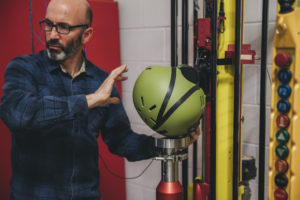
Connery, like his counterparts at helmet manufacturers POC, Smith, Pret and Giro, is doing everything he can to keep your noggin safe. “[When designing helmets for Anon,] I try to combine materials to allow the head to decelerate over a longer period of time during an impact and [thereby] reduce the force transmitted to the head,” says Connery of his research.
As the market has shifted over the past ten years from serving primarily ski racers to supporting helmets for recreational skiers and riders, helmet manufacturers have added innovative features like adjustable vents and magnetic chin straps. In 2010, Swedish body armor maker POC began building Multi-Directional Impact Protection Systems (MIPS) into ski helmets. What one gearhead we interviewed called, “the biggest thing to happen in helmets in 20 years,” MIPS is designed to protect the head against rotational forces from an angled impact by slowing the rate at which your head decelerates during a collision.
However, a study published this year by researchers at the University of Vermont found that while skier injuries overall have declined over the last 35 years and helmet use is on the rise, the rates of traumatic brain injuries sustained by skiers and riders remain constant.
Have these innovations worked? Between 1995 and 2012, the percentage of skiers at American ski areas who wore helmets increased from 8 to 84 percent, according to a study published in 2015 in the Journal of ASTM International. The authors of the study found that over the same period of time, the prevalence of head injuries decreased from 8.4 percent to 6.8 percent. Of 10 observed skull fractures, only one occurred while a skier was wearing a helmet.
Dr. Nate Endres of the University of Vermont Orthopedics Department has been studying skiing related injuries for several years and is working to establish original research on the topic. In a review to be published in Sports Health in 2019, he found that, overall, the frequency of skiing injuries in Vermont declined by 55 percent over the 35 years from 1972 to 2006.
Despite this pattern, head and neck injuries still account for 13 percent of all skiing and snowboarding-related injuries nationwide. According to Endres, that figure has remained relatively constant over the years, despite increased helmet use. According to Endres’ study, so has the frequency with which skiers and snowboarders die from traumatic injuries, of which brain injuries are the most common.
Endres points out that helmets are great at protecting against facial trauma, skull fractures and penetrative injuries, but they have their limits. A 2018 study from the British Journal of Sports Medicine found that in 7 of 9 videotaped crashes by FIS World Cup ski racers resulting in head injuries, the recorded pre-impact velocity of
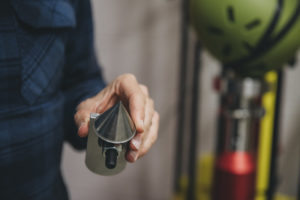
the head was greater than the maximum speed of 6.8 meters per second required by FIS for helmet tests. In fact some skiers’ heads were moving twice that fast when they hit the ground.
“Though there is no good reason not to wear a helmet these days, there is a threshold beyond which they just don’t protect the head,” says Endres.
And you don’t have to be a racer going 40 mph or an advanced rider to need one. A 2005 study by the American Society for Testing and Materials (ASTM) of skier and snowboarder behavior across the United States found that at resorts, recreational skiers traveled at an average highest speed of 27.6 miles per hour while snowboarders traveled at an average highest speed of 24 miles per hour. In 2009, actress Natasha Richardson died after sustaining an undiagnosed traumatic brain injury during a minor fall on a bunny slope at Mont Tremblant during a beginners’ ski lesson. She was not wearing a helmet at the time.
Just How Safe are Ski Helmets?
Dr. Matthew Gammons, the Medical Director of Sports Medicine at Killington Medical Clinic and Rutland Regional Medical Center, treats a lot of concussed skiers and riders. He is a past president of the American Medical Society for Sports Medicine and is a former team physician for the U.S. Ski Team.
Gammons, whose undergraduate degree was in biomechanical engineering, says, “helmets do a pretty good job at helping to protect the head in collisions at low to moderate speeds, but they don’t protect against concussions and don’t make much of a difference at really high speeds.” To make matters more challenging, “It’s not clear why some individuals experience long-lasting or permanent damage from relatively minor collisions and impacts and why some people appear to be fine after major collisions.”
With regard to concussions, Gammons says, “we’ve misinformed the public about what the capabilities of helmets are and that’s probably a disservice.”
Gammons says concussions and more serious traumatic brain injuries are caused by forces at work inside of your skull that are difficult to model in a laboratory setting. “Think of your brain like a big block of Jell-O on a plate. That’s about the consistency of live brain tissue,” says Gammons.
He described a scenario in which a skier takes a hard fall and hits their head against the ground, stopping suddenly. “The Jell-O inside the skull was moving in one direction, then suddenly it stops, deforms in the forward direction, and then moves back in the other direction.”
When this happens, he says, the brain tissue is pulled in opposite directions, causing axons, the fibers that connect it, to stretch in the microseconds during which the collision takes place.
“This is an incredibly complex thing that’s happening from an engineering standpoint,” says Connery. “The medical community is still trying to understand what happens during a concussion and it’s actually really difficult to model all of the forces that are transmitted when you have an impact to the head and in particular to the brain.”
This is even true for helmets outfitted with MIPS, an elastic layer that allows the shell and liner to slide relative to the head upon an angular impact, with the goal of protecting the head against the sort of angular motion researchers believe causes a concussion. Though successful experiments have been conducted to test how well MIPS-equipped helmets can protect crash test dummy heads—and its rotational function has been proven to work—Gammons says it remains unproven whether the technology better protects the brain.
Connery echoed this, saying, “We don’t have a way to measure the internal forces that are being applied [during an impact to the head]. We only have the ability to measure external forces. There is a lot of energy that is absorbed in the impact equation. MIPS does a bit, but the EPS [industry-grade Styrofoam] still does most of the work,” says Connery, who tests both helmets that use the system and those that don’t.
What’s the Best Helmet?
Unlike in Europe, there are no mandatory safety regulations a helmet manufacturer has to meet to sell their product in the United States. However, to ward off liability, most manufacturers test their helmets to the standards for “non-motorized snowsports” set forth by ASTM (you can see their sticker on the rear interior of helmets they’ve certified).
Essentially, a helmet must prevent a “head” from experiencing too much G-force as it impacts each of the objects described previously at -6 degrees Fahrenheit, 98 degrees Fahrenheit and 106 degrees Fahrenheit, with an impact speed of about 14 miles per hour. Under those circumstances, the helmet must ensure that no more than 300g of force is transferred to the test head on impact. Each ASTM-certified helmet passes this test by withstanding this impact when dropped from a height of two meters with a five kilogram solid, head-shaped weight strapped inside of it.
Beyond that, says Connery, one helmet is just about as safe as the next. What distinguishes them are features that improve fit and ventilation, how lightweight they are and things like removable earphone pockets.
Ski and snowboard helmets—like bike helmets—are single-use. This means that their structural integrity is compromised after one serious impact. The industry standard is to build helmets out of expanded polystyrene, also known as EPS, which is essentially a series of beads forced together in a manufacturing process and calibrated to tear and shear in predictable ways. It’s very light and is designed to absorb the force of an impact to the head by tearing and breaking.
This might seem counter-intuitive but, as Connery explains, helmets are designed to take the tremendous force generated when your head hits the ground or another object and transfer it away from your brain. “Breaking something is a really good way to release kinetic energy,” he says.
Ideally, the industrial-grade Styrofoam breaks so your head doesn’t have to. “EPS doesn’t absorb an impact like rubber or other materials, which deform on impact and then spring back. Instead, it releases that energy by compressing to a point, then snapping,” explains Connery. “It’s precisely the fact that it doesn’t rebound and transfer all of that kinetic energy from the impact back into your skull that makes it such a good helmet material.”
However, EPS, like Styrofoam, starts to degrade after about five to ten years, compromising its structural stability. “As the helmets get older, the bonds between the material beads in the impact layer break down. When the helmet receives an impact, it relies on these mechanical bonds between the beads to absorb energy so when the material is weak, either due to age or a previous impact, it causes more impact to transfer to the head and not be absorbed by the helmet as it crushes,” says Connery.
In general, Connery says that if you take a fall and see an imprint of your liner in the EPS in your helmet or any other deformities, it’s time to replace it. He’s replaced three cycling helmets following cyclocross and mountain bike crashes in the last three years and said, “Having tested those deformed helmets in the lab, I can state emphatically that if you see any damage on the inside or outside of the helmet that looks like the smallest of cracks or compression, you should replace it.”
Helmet or no?
According to one study published by the National Ski Areas Association in 2017, 89 percent of all minors wore helmets consistently throughout the 2016-2017 ski and snowboard season and 80 percent of skiers and snowboarders overall wore helmets.
And why wouldn’t they? As designers like Connery can attest, even more affordable helmets are now lightweight, durable and offer features that make them more comfortable to wear than a hat. Endres went so far as to call not wearing a helmet “just stupid.”
“There is a lot of data to suggest that if you protect your head, you will be in better shape in the event of an impact,” says Connery.
If you want a lighter helmet, try an in-mold model. Like bike helmets, they are made of one piece of molded EPS. They are just as strong, a little more susceptible to wear and tear over time than hard-shell helmets and much lighter. For a cheaper, more durable option, Connery recommends a hard shell helmet, which features an EPS interior bonded to a separate shell that is typically made from a high-impact ABS plastic.
“At the end of the day, the best helmet for you is the one you can afford and that you will wear consistently,” says Gammons. “If you can afford a helmet with MIPS technology, that’s great, but the main thing is to look for something that meets the industry standards and fits properly.”
The Best Helmets of 2019
Just like with boots, if you’re buying a helmet, it’s worth taking a trip to your local ski shop to get fitted. It’s also a good idea to replace your ski or snowboard helmet every five to ten years. “By the time you get to 15, 20 years of use, a helmet will degrade like an old Styrofoam cup,” says veteran Skirack bootfitter Doug Stewart.
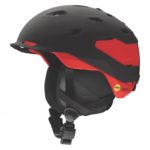
Smith Quantum MIPS ($299): This MIPS helmet features a lightweight, super-breathable AercoreTM interior, made of a super strong honeycomb material called Koroyd, in addition to traditional EPS. It comes with 22 adjustable vents, a BoaA fit adjustment dial and a magnetic strap buckle for one-handed adjustments on the chairlift.
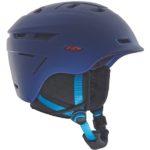 Anon Echo and Omega MIPS ($189.95): This is Dave Connery’s top pick and what he tours with. It features 15 vents, is an in-mold helmet, is lightweight (it weighs less than one pound) and has a magnetic lock closure for the strap. You can save a little by opting out of the MIPS model. “I wear it for side country tours because the venting system is comfortable enough that I can wear it while moving uphill,” says Connery.
Anon Echo and Omega MIPS ($189.95): This is Dave Connery’s top pick and what he tours with. It features 15 vents, is an in-mold helmet, is lightweight (it weighs less than one pound) and has a magnetic lock closure for the strap. You can save a little by opting out of the MIPS model. “I wear it for side country tours because the venting system is comfortable enough that I can wear it while moving uphill,” says Connery.
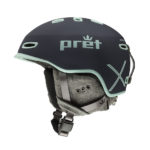 Pret Lyric X and Haven X MIPS ($120): At 395g, this is a lightweight but affordable helmet perfect for touring. It features a closed vent but effective in-mold design, MIPS technology, a magnetic chin strap for easy removal and a liner made with blended wool and recycled fleece.
Pret Lyric X and Haven X MIPS ($120): At 395g, this is a lightweight but affordable helmet perfect for touring. It features a closed vent but effective in-mold design, MIPS technology, a magnetic chin strap for easy removal and a liner made with blended wool and recycled fleece.
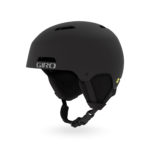 Giro Ledge MIPS ($80): “Giro is a part-owner in MIPS, which means that you can often get the technology in their helmets without the premium cost you see in other brands,” says Stewart. If MIPS is important to you, Giro’s Ledge model offers the added protection for just $80 in a hard-shell construction with fixed vents, something Stewart says is just about impossible to find. “It’s at the $100 price point that you start to see features like adjustable vents,” says Stewart.
Giro Ledge MIPS ($80): “Giro is a part-owner in MIPS, which means that you can often get the technology in their helmets without the premium cost you see in other brands,” says Stewart. If MIPS is important to you, Giro’s Ledge model offers the added protection for just $80 in a hard-shell construction with fixed vents, something Stewart says is just about impossible to find. “It’s at the $100 price point that you start to see features like adjustable vents,” says Stewart.
Featured Photo Caption: At Okemo, pictured above, Stowe and all Vail Resorts properties, helmets are a mandatory part of any equipment rental package. Photo courtesy Okemo Mountain Resort.

